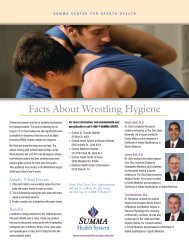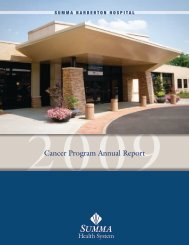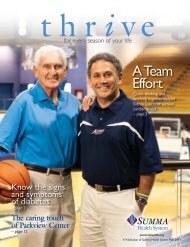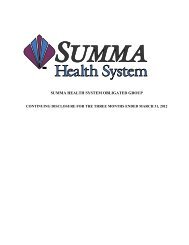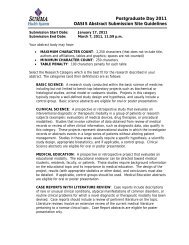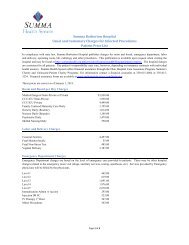SUM0506.116 A-FIB - Summa Health System
SUM0506.116 A-FIB - Summa Health System
SUM0506.116 A-FIB - Summa Health System
Create successful ePaper yourself
Turn your PDF publications into a flip-book with our unique Google optimized e-Paper software.
Minimally Invasive<br />
Gynecologic Surgery<br />
Advanced technology<br />
provides exciting alternatives<br />
to traditional surgery.<br />
<strong>Summa</strong>’s Minimally Invasive Surgery Institute equips<br />
surgeons to operate through tiny dime-size surgical<br />
openings without cutting through large areas of skin<br />
and muscle. These advanced laparoscopic procedures<br />
utilize specialized instruments and a laparoscope (a thin,<br />
lighted tube with a miniature camera), giving surgeons<br />
an enhanced view of the surgical field and far more<br />
control over very precise movements. Minimally<br />
invasive surgery offers patients:<br />
• Less pain<br />
• Less scarring<br />
• Less risk of infection<br />
• Less blood loss<br />
• Shorter hospital stay<br />
• Faster recovery<br />
World-class gynecologic oncology care.<br />
<strong>Summa</strong>’s gynecologic oncology subspecialists are highly trained in ovarian,<br />
cervical, vaginal and endometrial cancers. These surgeons are also actively<br />
involved in research endeavors related to the treatment and cure of these<br />
diseases.<br />
At <strong>Summa</strong>’s Akron City Hospital, surgeons use the state-of-the-art da Vinci ®<br />
Robotic Surgical <strong>System</strong> to perform minimally invasive radical hysterectomies<br />
and lymphadenectomies. For cervical cancer patients, the technology offers<br />
significantly less morbidity than an abdominal radical hysterectomy.<br />
• Laparoscopically Assisted Vaginal Hysterectomy (LAVH) usually requires<br />
a small abdominal incision for the laparoscope, a one-inch incision at the top<br />
of the vagina, one day in the hospital and a one to two-week recovery. Even<br />
women with large uterine fibroids may be candidates for LAVH.<br />
• Laparoscopic Supracervical Hysterectomy (LSH) and Total Laparoscopic<br />
Hysterectomy (TLH) are performed using only laparoscopic instruments.<br />
TLH removes the cervix and uterus, while LSH removes only the uterus. Both<br />
usually require one day in the hospital and a one to two-week recovery.<br />
<strong>Summa</strong> offers the area’s only da Vinci ® Robotic Surgical <strong>System</strong> and highly<br />
trained surgeons well-versed in its use. Approved by the FDA for gynecological<br />
laparoscopic procedures, this groundbreaking robotic tool extends the surgeon’s<br />
capabilities with enhanced 3-D visualization and greater surgical precision.<br />
New techniques for hysterectomy<br />
<strong>Summa</strong> surgeons offer a variety of open and minimally-invasive procedures.<br />
Whether a patient is a candidate for minimally invasive surgery depends on<br />
her diagnosis, age and medical condition.<br />
• Vaginal Hysterectomy (VH) requires no abdominal incision. It usually<br />
requires one day in the hospital and a one to two-week recovery.<br />
www.summahealth.org<br />
kmi/10-07/2k
Reproductive Endocrinology and Infertility<br />
<strong>Summa</strong>’s board-certified reproductive endocrinologists perform surgical procedures to improve fertility,<br />
including laparoscopy, myomectomy, uterine septum excision and vaginal reconstruction, as well as in<br />
vitro fertilization.<br />
Minimally invasive surgery (MIS) allows us to work through a 5mm incision for treatment of endometriosis,<br />
removal of pelvic adhesions, evaluation for infertility and removal of leiomyomas (fibroids). MIS also<br />
decreases recovery time, post-operative pain, adhesion formation and hospitalization.<br />
Urogynecology<br />
Our urogynecologists offer a variety of surgical procedures to treat the symptoms of urinary incontinence<br />
and pelvic floor disorders. For patients with less severe incontinence, our specialists can also provide<br />
nonsurgical evaluation and treatment.<br />
Robotic Sacrocervicolpopexy for prolapse allows women with severe pelvic prolapse to be treated<br />
laparoscopically. Using the da Vinci® Surgical <strong>System</strong>, <strong>Summa</strong> surgeons perform a laparoscopic<br />
supracervical hysterectomy (LSH), then attach mesh between the cervix and the backbone to support<br />
the vagina.<br />
Essure Tubal Ligation<br />
The Essure device is the first noninvasive, FDA-approved alternative to tubal ligation, designed for<br />
women seeking a nonsurgical option to permanent birth control. The outpatient procedure can be<br />
performed in about 10 to 20 minutes, and patients usually go home in 45 minutes. Over 90 percent of<br />
women return to normal activities within 24 hours or less. In three-year clinical trials, the properly<br />
implanted Essure device was 99.8 percent effective against pregnancy...slightly better than standard<br />
tubal ligation or vasectomy.<br />
For more information or the name<br />
of a specialist, ask your physician<br />
or visit our physician directory at<br />
www.summahealth.org.<br />
Non-Surgical Endometrial Ablation<br />
For women suffering from excessive menstrual bleeding (menorrhagia), <strong>Summa</strong> offers NovaSure<br />
Endometrial Ablation. This quick, safe and simple one-time procedure takes approximately four (4) minutes<br />
and requires no pretreatment. It removes the uterine lining while preserving the uterus and offers an<br />
excellent success rate…without hormones or hysterectomy.<br />
www.summahealth.org





